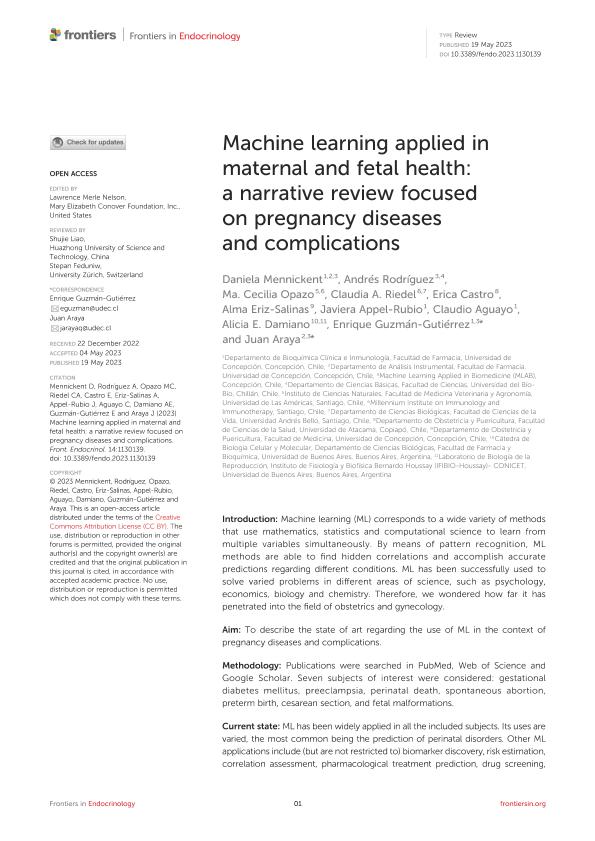Mostrar el registro sencillo del ítem
dc.contributor.author
Mennickent, Daniela
dc.contributor.author
Rodríguez, Andrés
dc.contributor.author
Opazo, María Cecilia
dc.contributor.author
Riedel, Claudia A.
dc.contributor.author
Castro, Erica
dc.contributor.author
Eriz Salinas, Alma
dc.contributor.author
Appel Rubio, Javiera
dc.contributor.author
Aguayo, Claudio
dc.contributor.author
Damiano, Alicia Ermelinda

dc.contributor.author
Guzmán Gutiérrez, Enrique
dc.contributor.author
Araya, Juan
dc.date.available
2024-02-21T12:43:40Z
dc.date.issued
2023-05
dc.identifier.citation
Mennickent, Daniela; Rodríguez, Andrés; Opazo, María Cecilia; Riedel, Claudia A.; Castro, Erica; et al.; Machine learning applied in maternal and fetal health: A narrative review focused on pregnancy diseases and complications; Frontiers Media; Frontiers in Endocrinology; 14; 1130139; 5-2023; 1-22
dc.identifier.uri
http://hdl.handle.net/11336/227723
dc.description.abstract
Introduction: Machine learning (ML) corresponds to a wide variety of methods that use mathematics, statistics and computational science to learn from multiple variables simultaneously. By means of pattern recognition, ML methods are able to find hidden correlations and accomplish accurate predictions regarding different conditions. ML has been successfully used to solve varied problems in different areas of science, such as psychology, economics, biology and chemistry. Therefore, we wondered how far it has penetrated into the field of obstetrics and gynecology. Aim: To describe the state of art regarding the use of ML in the context of pregnancy diseases and complications. Methodology: Publications were searched in PubMed, Web of Science and Google Scholar. Seven subjects of interest were considered: gestational diabetes mellitus, preeclampsia, perinatal death, spontaneous abortion, preterm birth, cesarean section, and fetal malformations. Current state: ML has been widely applied in all the included subjects. Its uses are varied, the most common being the prediction of perinatal disorders. Other ML applications include (but are not restricted to) biomarker discovery, risk estimation, correlation assessment, pharmacological treatment prediction, drug screening, data acquisition and data extraction. Most of the reviewed articles were published in the last five years. The most employed ML methods in the field are non-linear. Except for logistic regression, linear methods are rarely used. Future challenges: To improve data recording, storage and update in medical and research settings from different realities. To develop more accurate and understandable ML models using data from cutting-edge instruments. To carry out validation and impact analysis studies of currently existing high-accuracy ML models. Conclusion: The use of ML in pregnancy diseases and complications is quite recent, and has increased over the last few years. The applications are varied and point not only to the diagnosis, but also to the management, treatment, and pathophysiological understanding of perinatal alterations. Facing the challenges that come with working with different types of data, the handling of increasingly large amounts of information, the development of emerging technologies, and the need of translational studies, it is expected that the use of ML continue growing in the field of obstetrics and gynecology.
dc.format
application/pdf
dc.language.iso
eng
dc.publisher
Frontiers Media

dc.rights
info:eu-repo/semantics/openAccess
dc.rights.uri
https://creativecommons.org/licenses/by/2.5/ar/
dc.subject
ADVERSE PERINATAL OUTCOMES
dc.subject
ARTIFICIAL INTELLIGENCE
dc.subject
MACHINE LEARNING
dc.subject
PREGNANCY COMPLICATIONS
dc.subject
PREGNANCY DISEASES
dc.subject.classification
Patología

dc.subject.classification
Medicina Básica

dc.subject.classification
CIENCIAS MÉDICAS Y DE LA SALUD

dc.title
Machine learning applied in maternal and fetal health: A narrative review focused on pregnancy diseases and complications
dc.type
info:eu-repo/semantics/article
dc.type
info:ar-repo/semantics/artículo
dc.type
info:eu-repo/semantics/publishedVersion
dc.date.updated
2024-02-20T12:41:51Z
dc.identifier.eissn
1664-2392
dc.journal.volume
14
dc.journal.number
1130139
dc.journal.pagination
1-22
dc.journal.pais
Suiza

dc.journal.ciudad
Lausana
dc.description.fil
Fil: Mennickent, Daniela. Machine Learning Applied in Biomedicine; Chile. Universidad de Concepción; Chile
dc.description.fil
Fil: Rodríguez, Andrés. Universidad del Bio Bio; Chile. Machine Learning Applied in Biomedicine; Chile
dc.description.fil
Fil: Opazo, María Cecilia. Millennium Institute On Immunology And Immunotherapy; Chile. Universidad de Las Américas; Chile
dc.description.fil
Fil: Riedel, Claudia A.. Universidad Andrés Bello; Chile. Millennium Institute On Immunology And Immunotherapy; Chile
dc.description.fil
Fil: Castro, Erica. Universidad de Atacama; Chile
dc.description.fil
Fil: Eriz Salinas, Alma. Universidad de Concepción; Chile
dc.description.fil
Fil: Appel Rubio, Javiera. Universidad de Concepción; Chile
dc.description.fil
Fil: Aguayo, Claudio. Universidad de Concepción; Chile
dc.description.fil
Fil: Damiano, Alicia Ermelinda. Universidad de Buenos Aires. Facultad de Farmacia y Bioquímica. Departamento de Ciencias Biológicas. Cátedra de Biología Celular y Molecular; Argentina. Consejo Nacional de Investigaciones Científicas y Técnicas. Oficina de Coordinación Administrativa Houssay. Instituto de Fisiología y Biofísica Bernardo Houssay. Universidad de Buenos Aires. Facultad de Medicina. Instituto de Fisiología y Biofísica Bernardo Houssay; Argentina
dc.description.fil
Fil: Guzmán Gutiérrez, Enrique. Machine Learning Applied In Biomedicine; Chile. Universidad de Concepción; Chile
dc.description.fil
Fil: Araya, Juan. Universidad de Concepción; Chile. Machine Learning Applied In Biomedicine; Chile
dc.journal.title
Frontiers in Endocrinology
dc.relation.alternativeid
info:eu-repo/semantics/altIdentifier/doi/http://dx.doi.org/10.3389/fendo.2023.1130139
dc.relation.alternativeid
info:eu-repo/semantics/altIdentifier/url/https://www.frontiersin.org/journals/endocrinology/articles/10.3389/fendo.2023.1130139/full
Archivos asociados
